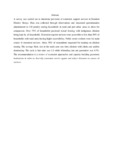| dc.contributor.author | Mwobobia, Royford M | |
| dc.contributor.author | Kanui, Titus I. | |
| dc.contributor.author | Amwata, Dorothy A. | |
| dc.date.accessioned | 2018-01-23T13:18:29Z | |
| dc.date.available | 2018-01-23T13:18:29Z | |
| dc.date.issued | 2016-03 | |
| dc.identifier.citation | International Journal of Livestock Research, Vol 6(03 ) Mar’ 16: 8-15 | en_US |
| dc.identifier.issn | 2277-1964 | |
| dc.identifier.uri | https://www.researchgate.net/publication/298735407_Extension_Support_Services_among_Poultry_Farmers_a_Case_of_Katulani_District_Kitui_County | |
| dc.identifier.uri | http://hdl.handle.net/123456789/2972 | |
| dc.description.abstract | A survey was carried out to determine provision of extension support services in Katulani District, Kenya. Data was collected through observations and structured questionnaires administered to 110 poultry rearing households in rural and peri urban areas to allow for comparison. Over 75% of households practiced mixed farming with indigenous chicken being kept by all households. Extension support services were accessible to less than 50% of households with rural areas having higher accessibility. Public sector workers were the main source of extension services. About 50% of respondents requested for training on chicken rearing. The average flock size in the study area was forty chicken with chicks and pullets dominating. The cock to hen ratio was 1:2 while inbreeding rate per generation was 4.5%. The recommendation is a review of extension approaches and capacity building grassroots institutions in order to diversify extension service agents and reduce distances to source of services. | en_US |
| dc.language.iso | en | en_US |
| dc.subject | Chicken | en_US |
| dc.subject | Extension | en_US |
| dc.subject | Katulani | en_US |
| dc.subject | Livelihood | en_US |
| dc.subject | Peri Urban | en_US |
| dc.subject | Rural | en_US |
| dc.subject | Support services | en_US |
| dc.title | Extension Support Services among Poultry Farmers, a Case of Katulani District, Kitui County | en_US |
| dc.type | Article | en_US |

